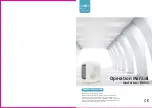
1- INTRODUCTION
You are now the owner of a
Quatro IVac System
, an advanced effective indoor air purification system
designed specifically to remove particulate matter. You can expect a noticeable improvement in air quality as
the
IVac
begins the process of reducing microscopic airborne particulate.
PRINCIPLE OF OPERATION
The
iVAC
features a four step AUTOMATIC method of operation:
a) rear knockout chamber forces heavier particles to the tray; b) filter captures and holds lighter dust particles; c)
AUTOMATIC CLEANING SYSTEM loosens and releases lighter particles captured in the filter down into tray followed
by a cerified HEPA filter d) heavy duty blower section to overcome static pressure across the hose and filter.
UP/DOWN Arrows on control panel allow you to increase and decrease speed in 10 increments.
Tray beneath the filter can be easily released and unloaded, without manipulating the filter. This allows for easy and
clean debris removal.
UNIT INSPECTION
Upon receipt, inspect unit for either visible or concealed damage. Damage should be immediately reported to the
transport company.
If you suspect concealed damages inside the box indicate so on the transport companies’ shipping
documents.
Bottom drawer of unit contains: a) Power cordset, b) 2”dia. 8 foot hose, c) Communication cable (9-pin),
d) (4) EXTRA motor brushes, e) O&M manual.
Place extra motor brushes & manual in safe place for future use. Motor brushes will wear & must be replaced.
These brushes will provide you with 1 replacement, please order next set after replacing, to avoid urgency.
2- IMPORTANT SAFETY PRECAUTIONS
WARNING- To reduce the risk of severe injury read and follow all instructions
-To reduce the risk of electric shock, do not expose to water or rain. Do not operate the system in
areas with excessive moisture .
-Ensure to use proper voltage as noted on the serial # sticker
-All filters must be in place whenever this machine is in operation.
-Use only on a grounded electrical circuit; do not use any two-wire electrical prong adapters to defeat
the three-pronged plug on the end of the cord
.
-Disconnect power prior to accessing unit, when checking or replacing filters, or servicing motor (blower).
-When servicing the motors be careful when touching the exterior of the motor as soon as it has been
turned off; it may be hot enough to be painful or cause injury. With modern motors, this condition is
normal when operated at rated load and voltage, as they are built to operate at higher temperatures.
SAVE THE INSTRUCTION MANUAL FOR FUTURE REFERENCE
Ensuring Proper Grounding of ABS/PVC Fittings and Tubing for a Dust Collection System.
For dust collection systems, galvanized metal pipe and fittings are best, but for most typical applications, fittings and
dust collection tubing made of plastic (ABS or PVC) are sufficient, provided they are
properly grounded
to dissipate
static electrical charges. Dust and air in the right proportions can be an explosive mixture, and a build up of static
electricity can provide the spark to ignite it.
To safely collect and bleed off the static charge, bare copper wire (not insulated) should be run along the inside of the
duct-work and be attached to grounding screws or a bare metal surface on both the dust collector and the unit that it is
connected to (if it is connected to a unit). The power cords of both machines must be terminated in a grounded three-
prong plug to complete the connection to the ground. Wires over the irregularities of fittings, especially at “Y”s or “T”s
could form traps for particles. Therefore, bypass the fittings by running the wires to the outside through small holes.
Seal the holes with silicone caulking compound and join the wires by twisting them together and securing them with a
wire nut.
As charges can also collect on the outside surface, we recommend wrapping bare copper wire in a spiral around the
outside of the ductwork, securing it with electrical tape and connecting it to the ground system by means of wire nuts. If
you have any difficulty securing the hose clamp to the hose and fittings, try wrapping the joints with duct tape first to
provide a good gripping surface. If you are still having difficulty in obtaining a safe electrical ground, we recommend the
services of a good electrician.




























